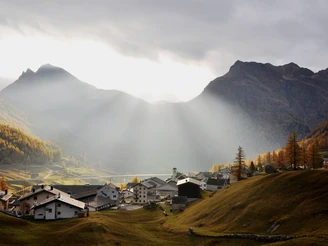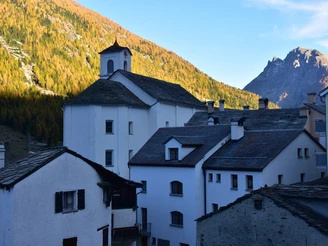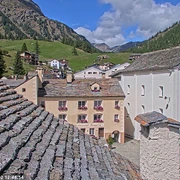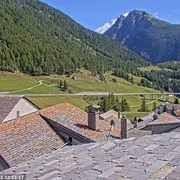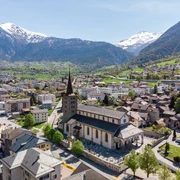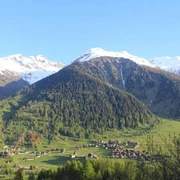- Photos & Map
How would you like to arrive?
- Description
- Good to know
- Nearby
Download GPX file
- 0:45 h
- 871 m
- 32 m
- 32 m
- 1,448 m
- 1,477 m
- 29 m
- Start: Hotel Post, Simplon Dorf
- Destination: Hotel Post, Simplon Dorf
370 inhabitants live in the small mountain village of Simplon Dorf. The architectural style of the houses covered with granite slabs is influenced by Italy. This influence is also visible on the village square, which is designed in the style of a piazza. The narrow, cobbled streets and the intact, three-storey stone houses from the 17th century shape the character of the village.
In the old inn - built in several stages between the 14th and 18th centuries and now a museum - you can learn interesting facts about the development of international transit traffic and its influence on regional history.
Good to know
Pavements
Best to visit
Directions
Following the construction of the Simplonstrasse, the stately building was built around 1810 as a proud officers' barracks. The villagers called the building “Z'gross Huis”. The Frenchman Pierre Guillet, who lived in Simplon Dorf, set up an inn in it in 1812. In 1830, the municipality bought the house and the subsequent innkeepers continued to provide the postmaster's services. The garages on the first floor were converted into a modern restaurant, while the stables opposite now house the post office and the community hall. The milestone on the east façade of today's hotel marks exactly half the distance between Brig and Domodossola.
2: Old tower
For centuries, the tower was the village's landmark. “Där Turu” was once a mighty lord's tower. It was the seat of the noble family of the Lords of Simplono, masters of the Simplon valley from 1257 to 1335. In 1334, Bishop Aymon of Sion acquired the building and set up a suste on the first floor. After the decline of the feudal power structures, the municipality acquired the building in 1545 and set up the parish hall and the first school in it. Part of the dilapidated building collapsed in 1892 and half of the structure was demolished. In 1893/94, the parish erected the current building on the foundation walls. Only the round staircase remains of the historic tower.
3: Alpine dairy
Agriculture is very important in the Simplon region. All plots of land are farmed, the estates and alps are accessible by road and irrigation systems are installed in the meadows. The farm buildings are located close to the edge of the village. The village dairy is the center and the lifeblood of the farmers. The façade is decorated with the last great work of the Upper Valais painter Anton Mutter. Cheese, butter, cream, yoghurt and Ziger from the Simplon dairy also have an excellent reputation in neighboring Italy. Guided tour of the dairy by appointment Tel. 027 979 13 66. Shop opening hours: Daily 08:00 - 12:00 and 16:00 - 18:00.
4: Schoolhouse
The school building from 1964 replaced the school in the old tower and was renovated in 1999 and 2002. The gymnasium with a modern stage and a large, modern kitchen is suitable for a wide range of large events. Village library, computer room. The school workshops and teaching kitchen serve all school classes from kindergarten to elementary school. The main entrance is adorned with an iron sculpture by the Upper Valais painter Anton Mutter.
5: Work yard
The depot was completed in 1989 according to the plans of P. Schweizer and A. Meillard. The façade is reminiscent of the road buildings of the Napoleonic era and the stone slab roof is in keeping with the appearance of the village. The section of the A9 national road from the Simplon Pass to Gondo (national border CH/I) is monitored and maintained from here.
6: Federal Councillor Josef Escher House
This modest plaque commemorates the birthplace of Dr. Josef Escher, the first Federal Councillor of Valais. He regularly spent his summer vacations on the second floor, even as a federal councillor, and maintained lively contact with his fellow citizens.
7: Old mill
With the new village paving in 2010, the romantic stone arch bridges over the village stream were also repaired. The path leads to the old mill. The mill was still in operation in the last century.
8: Stutzji
A walk through z'Stutzji is a special experience. The buildings on both sides of the old mule track were built in the second half of the 17th century. The impressive alleyways reveal a southern influence and are among the most impressive wayside settlements in Switzerland. The “Stutzji” was repaved in 2010.
9: Village square
Designed in the style of an Italian piazza, the grand old village center is surrounded by mighty 17th century stone houses from the heyday of the Simplon and Kaspar von Stockalper (1609 - 1691): the former inn “Zum Weissen Kreuz” from 1679, the old Suste from 1611 and 1684, the salt house from 1728 and the “Simplon” inn from the second half of the 17th century, which is still in use today. With the vicarage from 1680 and the church from 1725, the square has a unique development. The octagonal stone village fountain (around 1870) was used as a horse trough. Since its renovation in 2008, the rectangular historic square has been aesthetically lined with old buildings and their historic facades, as it was in Stockalper's time, after a disruptive building built at a later date was removed. The new stone stage and the wild stone paving have revitalized the village square. The simple monument in the shadow of the old inn pays tribute to the achievements of the village's most famous citizen, Dr. Josef Escher, the first Federal Councillor of Valais. Josef Escher, born on September 17, 1885, a native of Simplon Dorf, was elected Federal Councillor on September 14, 1950. The CVP Federal Councillor headed the Post and Railway Department. He died on December 9, 1954 during a Federal Council meeting, two weeks after announcing his resignation.
10: Old Inn Museum
The former inn and Susten building was constructed in several stages between the 14th and 18th centuries. In the typical Simplon village construction style, the wooden log walls were encased with walls. The impressive enclosure wall with the mighty gate entrance is a reminder of the historical significance of the building. After being purchased by the municipality, the building, which was in danger of collapsing, was carefully restored in 1991-95. Today, “Där alt Gasthof” forms the actual center of the Ecomuseum. The museum's permanent exhibition is located in the interior rooms, which have been restored very close to the original. The exhibition focuses on international transit traffic and its impact on regional history. Interested visitors to the village should not miss out on a visit to this wonderful museum in Simplon Dorf.
11: Church
The parish of St. Gotthard in Simplon is mentioned in a document dated August 1, 1267 and celebrates its patron saint, St. Gotthard, a southern German bishop, on the anniversary of his death on May 5 (1083). The present church of St. Gotthard was built in 1725. The Gothic sacrament house in the wall to the right of the high altar and the candlestick from 1568 point to an earlier church building. The striking feature of today's church, which was renovated in 1961 and is strongly influenced by Italy, is its tall rectangular proportions. In the niche above the entrance is a bronze statue of St. Brother Klaus by the Obwalden sculptor Josef Gasser. The high altar (1827) with St. Bishop Gotthard is by Lorenz Justin Ritz. On the right is St. Nicholas of Myra, on the left St. Theodul, the first bishop of Valais. Above them Mary, Mother of God, on the right St. Catherine of Siena, on the left St. Dominic. God the Father hovers above them all. The two side altars are by Anton Sigristen with altarpieces by Melchior Paul von Deschwanden. The right-hand altar shows the death of St. Joseph, flanked on the right by St. Barbara and on the left by St. Catherine of Alexandria. Above it is St. George, to his right St. Aloisius and to his left St. Francis Xavier. The left altar is dedicated to St. Anne. On the right is St. John the Baptist, on the left St. Anthony of Padua. Above it is St. Cecilia, to her right St. Martha of Bethany and to her left St. Agatha.
12: Stable & barn in the Chrizgassa
This inconspicuous barn is the oldest secular log building in Switzerland. Using dendrochronology (tree ring analysis and comparison with other tree ring series), researchers have discovered that the building is around 1000 years old.
Tour information
Cultural Interesting
Loop Road
Stop at an Inn
Equipment
Directions & Parking facilities
Additional information
Literature
Author´s Tip / Recommendation of the author
Safety guidelines
Map
Nearby






